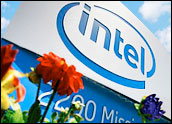
Intel plans to pull out all the stops to conquer the tablet PC market, CEO Paul Otellini announced this week.
Intel will use all of the assets at its disposal to win this segment, he said. Intel will offer tablets running Meego, the operating system that’s a melding of its and Nokia’s technologies. It will also pursue Android and Microsoft Windows, Otellini added. His statements were made during the company’s third quarter earnings call.
Currently, the semiconductor giant is offering its Oak Trail processors for tablets. These are part of the Intel Atom family.
“We’re already seeing tablets available now based on Intel Atom processors, including the Archos 9, Lenovo S10-3t, Cisco Cius, and Asus eeePad,” Intel spokesperson Suzy Ramirez told TechNewsWorld.
Can Intel’s processors take on the A4 that’s used by the iPad? Will Intel be successful in its plan to dominate the tablet PC market?
Hiding Out on the Oak Trail
Intel first announced the Oak Trail in June at the Computex show in Taipei. At that time, it said Oak Trail processors would be available to customers in early 2011
The Oak Trail platform is optimized for tablet and netbook designs. It consumes up to 50 percent less power than previous processors, offers full high-definition video, and is aimed at the Meego, Windows 7 and Android operating systems, Intel said.
Oak Trail is a system on a chip based on the Atom processor.
A system on a chip, or SOC, is a circuit into which multiple components are integrated. These may include digital, analog, mixed-signal and often radio-frequency functions.
Think of an SOC as a microcontroller on steroids — where microcontrollers usually have less than 100 KB of RAM and are single-chip systems, SOCs use more powerful processors requiring external memory chips and various external peripherals. SOCs reduce manufacturing costs and let manufacturers reduce the size of their devices.
However, Intel’s not letting out any more information about the Oak Trail processor.
“We have not disclosed any product features or additional details on Oak Trail,” Intel’s Ramirez said. “We’ve simply introduced the code name at this time. When it’s announced, we’ll offer more information.”
Atomic Attack
Tablets running Intel’s Oak Trail processors will be pitted against the iPad, which runs the A4 processor. The A4, designed by Apple and manufactured by Samsung, combines an ARM-based CPU with a PowerVR graphics processing unit and features very low power consumption.
Will Intel be able to compete?
“Atom has all the right features and capabilities that are important for tablets, including low power, performance for multitasking, rich media and the Internet,” Intel’s Ramirez said. “We already have several tablet designs in the market that are enabled by the Intel Atom processor.”
Perhaps Intel needs to do more work on the Oak Trail processor.
“They’re talking about x86 technology, which isn’t necessarily on par in power consumption with ARM technology, and ARM technology isn’t standing still,” Jim McGregor, chief technology analyst at In-Stat, pointed out.
“The Snapdragon and other ARM products won’t be single-core devices but multicore devices. So in the first quarter of 2011, you’ll have single-core Intel Atoms going up against multicore ARM-based devices that in some cases will have state-of-the graphics technology,” McGregor told TechNewsWorld.
“This is a battle about architecture,” Carl Howe, director of anywhere consumer technology, told TechNewsWorld. “Specifically, Otellini wants tablet computers to be x86-based, whereas the dominant tablet today, Apple’s iPad, and most smartphones are ARM-based.”
The Road Less Traveled
Perhaps Intel needs to rethink its approach.
“Apple’s coming at the tablet market as a commercial product developer, and Intel’s approach is to be a supplier of tablet developers who want to compete effectively against Apple,” Charles King, principal analyst at Pund-IT, told TechNewsWorld.
“What Intel really needs to do is produce a robust platform that’s also flexible enough to be tweaked for the discrete needs of different OEMs,” King added. “That’s a bigger challenge than Apple’s ‘one iPad fits all’ approach, but should also result in Intel-based tablets that can be designed for the needs of numerous discrete audiences.”
Intel’s apparently doing just the opposite.
“At this point, Intel’s sticking with what it’s got — Oak Trail,” In-Stat’s McGregor said. “It’s not customizing this significantly for vendors, and it has segmentation within the Atom product for each market segment — embedded chips, home consumer electronics, tablets and so forth. It’s all within Intel’s standard product offering.”






















































